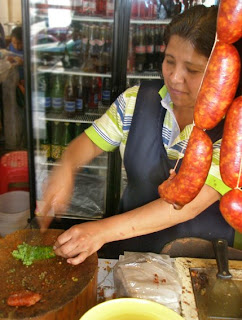
Tlaxcala, the smallest state in Mexico, is a mountainous area east of Mexico City, surrounded on three sides by the state of Puebla. The nahuatl name means "place of bread made with corn” (i.e. tortillas). Its capital city (also called Tlaxcala) is a pretty colonial gem filled with 17th and 18th century architectural marvels.
Naturally, this landlocked states’ food utilizes meats, fowl and herbs found in the area and is similar to, if less varied than that of Puebla. Hearty stews, thickened with seeds and nuts, habas (fava beans) and corn dishes reminiscent of pre-colonial times are the norm – it is a truly Mexican cuisine very much based on ancient tradition.
Near the Museo San Ildefonso, one of the city’s best contemporary art venues, I recently discovered Restaurante San Francisco, which specializes in the cuisine of Tlaxcala. Set within Casa Tlaxcala, a cultural center housed in a fine old colonial building, it’s a pleasant respite from the hustle and bustle of the city center. Open only for lunch, the reasonably priced menu offers some of the best known dishes from the region.
Start with a jarra verde Tlaxcala – a punch made with pulque (the
Naturally, this landlocked states’ food utilizes meats, fowl and herbs found in the area and is similar to, if less varied than that of Puebla. Hearty stews, thickened with seeds and nuts, habas (fava beans) and corn dishes reminiscent of pre-colonial times are the norm – it is a truly Mexican cuisine very much based on ancient tradition.
Near the Museo San Ildefonso, one of the city’s best contemporary art venues, I recently discovered Restaurante San Francisco, which specializes in the cuisine of Tlaxcala. Set within Casa Tlaxcala, a cultural center housed in a fine old colonial building, it’s a pleasant respite from the hustle and bustle of the city center. Open only for lunch, the reasonably priced menu offers some of the best known dishes from the region.

Start with a jarra verde Tlaxcala – a punch made with pulque (the
fermented sap of the maguey refined to produce tequila and mezcal), mint and lime. It’s refreshing and delicious, the yeasty flavor of the pulque not overwhelming. There are a number of appetizers to start your meal – a good choice is the platón Tlaxcalteco offering a selection of regional cheese, “antojitos” such as tamales and quesadillas, and chorizo – it’s large and can easily be shared by four people. While the salads are nicely presented, they are standard, nothing special, although the nopal (cactus) salad is particularly good, seasoned with cilantro and sprinkled with fresh cheese. Soups are more interesting: The sopa de habas con nopales (fava bean with cactus) is my favorite – it is a light cream, like split pea, the small shreads of cactus providing a nice tang; crema de cilantro, a mild but aromatic creamed soup.
The featured main dish is the pipian Tizatlán – made with either pork or chicken. The smooth green sauce of ground pumpkin seeds, chilies and aromatic green herbs is satisfying and earthy – you can tell this is Tlaxcalan ‘comfort food’. It differs from its Poblano cousin in the perfumy herbs used which give it an exotic and complex aroma.
The pollo Tocatlán may be Tlaxcala’s best known and most unusual dish. This savory stew is made with chicken and potatoes. The sauce, rich with roasted onions and tomatoes, smoky chayote chilies and perfumy cinnamon, is thickened with amaranth, a grain widely used in the region. It is a hardy dish worth trying.
Mole de olla, a soupy version of the Puebla classic is filled with fava beans, a variation particular to the region – it’s perfect food for a chilly day.
For those in a carnivorous mood, try the pit roasted barbacoa, popular all over central Mexico, or the cecina Zauapan, the Tlaxclala version of this popular dried and pounded meat.
Vegetarians don’t need to despair here – little burgers of huazontle, a green herb that tastes of asparagus, are bathed in a spicy sauce made with dried shrimp. Squash blossom flowers stuffed with fresh cheese with flecks of epazote, the odd medicinal tasting herb used all over central Mexico, are delectable.
There are some unusual desserts worth trying. Espuma de agave (a mousse made with tequila), panque de nopal (a sweet cactus cake), and my favorite, the refreshing gelatina de jamaica (flavored with dried hibiscus flowers)– Jell-o never tasted so good.
Nothing on the menu costs more than 100 pesos --a full meal will be around 150 per person, tops.
On the street a chalkboard announces a 48 peso “comida corrida”, but you won’t find it on the menu inside, so ask your waiter for details.
After your meal, be sure to check out the small gift shop selling crafts from the region – prices are reasonable.
San Francisco is a perfect place to bring out-of-towners during a tour of the sights – relaxing, and “muy mexicano”....try it, you’ll like it.
Restaurante San Francisco
San Ildefonso 40, Centro
Tel. 5702-9110
Open Monday through Saturday, 9-6PM
The featured main dish is the pipian Tizatlán – made with either pork or chicken. The smooth green sauce of ground pumpkin seeds, chilies and aromatic green herbs is satisfying and earthy – you can tell this is Tlaxcalan ‘comfort food’. It differs from its Poblano cousin in the perfumy herbs used which give it an exotic and complex aroma.
The pollo Tocatlán may be Tlaxcala’s best known and most unusual dish. This savory stew is made with chicken and potatoes. The sauce, rich with roasted onions and tomatoes, smoky chayote chilies and perfumy cinnamon, is thickened with amaranth, a grain widely used in the region. It is a hardy dish worth trying.
Mole de olla, a soupy version of the Puebla classic is filled with fava beans, a variation particular to the region – it’s perfect food for a chilly day.

For those in a carnivorous mood, try the pit roasted barbacoa, popular all over central Mexico, or the cecina Zauapan, the Tlaxclala version of this popular dried and pounded meat.
Vegetarians don’t need to despair here – little burgers of huazontle, a green herb that tastes of asparagus, are bathed in a spicy sauce made with dried shrimp. Squash blossom flowers stuffed with fresh cheese with flecks of epazote, the odd medicinal tasting herb used all over central Mexico, are delectable.
There are some unusual desserts worth trying. Espuma de agave (a mousse made with tequila), panque de nopal (a sweet cactus cake), and my favorite, the refreshing gelatina de jamaica (flavored with dried hibiscus flowers)– Jell-o never tasted so good.
Nothing on the menu costs more than 100 pesos --a full meal will be around 150 per person, tops.
On the street a chalkboard announces a 48 peso “comida corrida”, but you won’t find it on the menu inside, so ask your waiter for details.
After your meal, be sure to check out the small gift shop selling crafts from the region – prices are reasonable.
San Francisco is a perfect place to bring out-of-towners during a tour of the sights – relaxing, and “muy mexicano”....try it, you’ll like it.
Restaurante San Francisco
San Ildefonso 40, Centro
Tel. 5702-9110
Open Monday through Saturday, 9-6PM
This article previously appeared in The News: Mexico City









